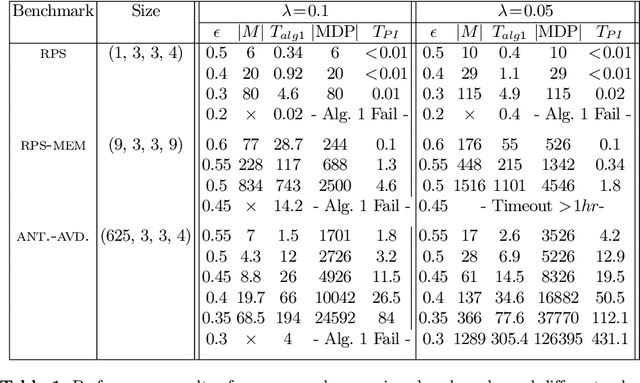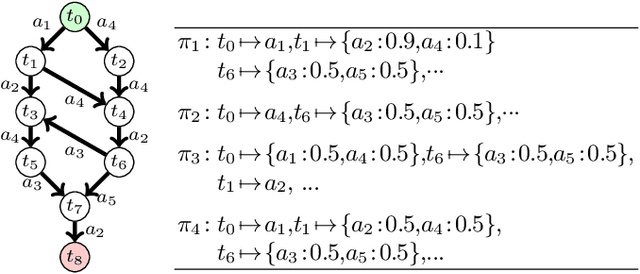Ashutosh Trivedi
University of Colorado Boulder
Explaining Hitori Puzzles: Neurosymbolic Proof Staging for Sequential Decisions
Aug 19, 2025Abstract:We propose a neurosymbolic approach to the explanation of complex sequences of decisions that combines the strengths of decision procedures and Large Language Models (LLMs). We demonstrate this approach by producing explanations for the solutions of Hitori puzzles. The rules of Hitori include local constraints that are effectively explained by short resolution proofs. However, they also include a connectivity constraint that is more suitable for visual explanations. Hence, Hitori provides an excellent testing ground for a flexible combination of SAT solvers and LLMs. We have implemented a tool that assists humans in solving Hitori puzzles, and we present experimental evidence of its effectiveness.
Explaining Puzzle Solutions in Natural Language: An Exploratory Study on 6x6 Sudoku
May 21, 2025Abstract:The success of Large Language Models (LLMs) in human-AI collaborative decision-making hinges on their ability to provide trustworthy, gradual, and tailored explanations. Solving complex puzzles, such as Sudoku, offers a canonical example of this collaboration, where clear and customized explanations often hold greater importance than the final solution. In this study, we evaluate the performance of five LLMs in solving and explaining \sixsix{} Sudoku puzzles. While one LLM demonstrates limited success in solving puzzles, none can explain the solution process in a manner that reflects strategic reasoning or intuitive problem-solving. These findings underscore significant challenges that must be addressed before LLMs can become effective partners in human-AI collaborative decision-making.
Technical Challenges in Maintaining Tax Prep Software with Large Language Models
Apr 25, 2025



Abstract:As the US tax law evolves to adapt to ever-changing politico-economic realities, tax preparation software plays a significant role in helping taxpayers navigate these complexities. The dynamic nature of tax regulations poses a significant challenge to accurately and timely maintaining tax software artifacts. The state-of-the-art in maintaining tax prep software is time-consuming and error-prone as it involves manual code analysis combined with an expert interpretation of tax law amendments. We posit that the rigor and formality of tax amendment language, as expressed in IRS publications, makes it amenable to automatic translation to executable specifications (code). Our research efforts focus on identifying, understanding, and tackling technical challenges in leveraging Large Language Models (LLMs), such as ChatGPT and Llama, to faithfully extract code differentials from IRS publications and automatically integrate them with the prior version of the code to automate tax prep software maintenance.
Benchmarking Vision-Language Models on Optical Character Recognition in Dynamic Video Environments
Feb 10, 2025



Abstract:This paper introduces an open-source benchmark for evaluating Vision-Language Models (VLMs) on Optical Character Recognition (OCR) tasks in dynamic video environments. We present a curated dataset containing 1,477 manually annotated frames spanning diverse domains, including code editors, news broadcasts, YouTube videos, and advertisements. Three state of the art VLMs - Claude-3, Gemini-1.5, and GPT-4o are benchmarked against traditional OCR systems such as EasyOCR and RapidOCR. Evaluation metrics include Word Error Rate (WER), Character Error Rate (CER), and Accuracy. Our results highlight the strengths and limitations of VLMs in video-based OCR tasks, demonstrating their potential to outperform conventional OCR models in many scenarios. However, challenges such as hallucinations, content security policies, and sensitivity to occluded or stylized text remain. The dataset and benchmarking framework are publicly available to foster further research.
Fairness Testing through Extreme Value Theory
Jan 20, 2025



Abstract:Data-driven software is increasingly being used as a critical component of automated decision-support systems. Since this class of software learns its logic from historical data, it can encode or amplify discriminatory practices. Previous research on algorithmic fairness has focused on improving average-case fairness. On the other hand, fairness at the extreme ends of the spectrum, which often signifies lasting and impactful shifts in societal attitudes, has received significantly less emphasis. Leveraging the statistics of extreme value theory (EVT), we propose a novel fairness criterion called extreme counterfactual discrimination (ECD). This criterion estimates the worst-case amounts of disadvantage in outcomes for individuals solely based on their memberships in a protected group. Utilizing tools from search-based software engineering and generative AI, we present a randomized algorithm that samples a statistically significant set of points from the tail of ML outcome distributions even if the input dataset lacks a sufficient number of relevant samples. We conducted several experiments on four ML models (deep neural networks, logistic regression, and random forests) over 10 socially relevant tasks from the literature on algorithmic fairness. First, we evaluate the generative AI methods and find that they generate sufficient samples to infer valid EVT distribution in 95% of cases. Remarkably, we found that the prevalent bias mitigators reduce the average-case discrimination but increase the worst-case discrimination significantly in 5% of cases. We also observed that even the tail-aware mitigation algorithm -- MiniMax-Fairness -- increased the worst-case discrimination in 30% of cases. We propose a novel ECD-based mitigator that improves fairness in the tail in 90% of cases with no degradation of the average-case discrimination.
Transfer Learning for Control Systems via Neural Simulation Relations
Dec 02, 2024



Abstract:Transfer learning is an umbrella term for machine learning approaches that leverage knowledge gained from solving one problem (the source domain) to improve speed, efficiency, and data requirements in solving a different but related problem (the target domain). The performance of the transferred model in the target domain is typically measured via some notion of loss function in the target domain. This paper focuses on effectively transferring control logic from a source control system to a target control system while providing approximately similar behavioral guarantees in both domains. However, in the absence of a complete characterization of behavioral specifications, this problem cannot be captured in terms of loss functions. To overcome this challenge, we use (approximate) simulation relations to characterize observational equivalence between the behaviors of two systems. Simulation relations ensure that the outputs of both systems, equipped with their corresponding controllers, remain close to each other over time, and their closeness can be quantified {\it a priori}. By parameterizing simulation relations with neural networks, we introduce the notion of \emph{neural simulation relations}, which provides a data-driven approach to transfer any synthesized controller, regardless of the specification of interest, along with its proof of correctness. Compared with prior approaches, our method eliminates the need for a closed-loop mathematical model and specific requirements for both the source and target systems. We also introduce validity conditions that, when satisfied, guarantee the closeness of the outputs of two systems equipped with their corresponding controllers, thus eliminating the need for post-facto verification. We demonstrate the effectiveness of our approach through case studies involving a vehicle and a double inverted pendulum.
Show, Don't Tell: Learning Reward Machines from Demonstrations for Reinforcement Learning-Based Cardiac Pacemaker Synthesis
Nov 04, 2024Abstract:An (artificial cardiac) pacemaker is an implantable electronic device that sends electrical impulses to the heart to regulate the heartbeat. As the number of pacemaker users continues to rise, so does the demand for features with additional sensors, adaptability, and improved battery performance. Reinforcement learning (RL) has recently been proposed as a performant algorithm for creative design space exploration, adaptation, and statistical verification of cardiac pacemakers. The design of correct reward functions, expressed as a reward machine, is a key programming activity in this process. In 2007, Boston Scientific published a detailed description of their pacemaker specifications. This document has since formed the basis for several formal characterizations of pacemaker specifications using real-time automata and logic. However, because these translations are done manually, they are challenging to verify. Moreover, capturing requirements in automata or logic is notoriously difficult. We posit that it is significantly easier for domain experts, such as electrophysiologists, to observe and identify abnormalities in electrocardiograms that correspond to patient-pacemaker interactions. Therefore, we explore the possibility of learning correctness specifications from such labeled demonstrations in the form of a reward machine and training an RL agent to synthesize a cardiac pacemaker based on the resulting reward machine. We leverage advances in machine learning to extract signals from labeled demonstrations as reward machines using recurrent neural networks and transformer architectures. These reward machines are then used to design a simple pacemaker with RL. Finally, we validate the resulting pacemaker using properties extracted from the Boston Scientific document.
Anticipating Oblivious Opponents in Stochastic Games
Sep 18, 2024



Abstract:We present an approach for systematically anticipating the actions and policies employed by \emph{oblivious} environments in concurrent stochastic games, while maximizing a reward function. Our main contribution lies in the synthesis of a finite \emph{information state machine} whose alphabet ranges over the actions of the environment. Each state of the automaton is mapped to a belief state about the policy used by the environment. We introduce a notion of consistency that guarantees that the belief states tracked by our automaton stays within a fixed distance of the precise belief state obtained by knowledge of the full history. We provide methods for checking consistency of an automaton and a synthesis approach which upon successful termination yields such a machine. We show how the information state machine yields an MDP that serves as the starting point for computing optimal policies for maximizing a reward function defined over plays. We present an experimental evaluation over benchmark examples including human activity data for tasks such as cataract surgery and furniture assembly, wherein our approach successfully anticipates the policies and actions of the environment in order to maximize the reward.
LLMs as Probabilistic Minimally Adequate Teachers for DFA Learning
Aug 06, 2024Abstract:The emergence of intelligence in large language models (LLMs) has inspired investigations into their integration into automata learning. This paper introduces the probabilistic Minimally Adequate Teacher (pMAT) formulation, which leverages a probabilistic oracle that could give persistent errors randomly during answering the membership queries for deterministic finite automata (DFA) learning. Given the tendency of LLMs to produce hallucinatory content, we have developed techniques to improve answer accuracy and ensure the correctness of the learned automata. We propose the $\mathtt{Discrimination}$ prompt as well as the $\mathtt{Verification}$ prompt and explore their advantages over common prompts. Additionally, we compare DFA learning performance between the TTT algorithm and common active learning algorithms. To address the exponential number of persistent errors, we implement a dynamic query cache refinement algorithm that identifies and corrects conflicting queries by combining the active and passive learning algorithms. The empirical results demonstrate the robustness and efficiency of our approach, providing a theoretical foundation for automata learning with LLMs in the loop.
Transfer of Safety Controllers Through Learning Deep Inverse Dynamics Model
May 22, 2024



Abstract:Control barrier certificates have proven effective in formally guaranteeing the safety of the control systems. However, designing a control barrier certificate is a time-consuming and computationally expensive endeavor that requires expert input in the form of domain knowledge and mathematical maturity. Additionally, when a system undergoes slight changes, the new controller and its correctness certificate need to be recomputed, incurring similar computational challenges as those faced during the design of the original controller. Prior approaches have utilized transfer learning to transfer safety guarantees in the form of a barrier certificate while maintaining the control invariant. Unfortunately, in practical settings, the source and the target environments often deviate substantially in their control inputs, rendering the aforementioned approach impractical. To address this challenge, we propose integrating \emph{inverse dynamics} -- a neural network that suggests required action given a desired successor state -- of the target system with the barrier certificate of the source system to provide formal proof of safety. In addition, we propose a validity condition that, when met, guarantees correctness of the controller. We demonstrate the effectiveness of our approach through three case studies.
 Add to Chrome
Add to Chrome Add to Firefox
Add to Firefox Add to Edge
Add to Edge